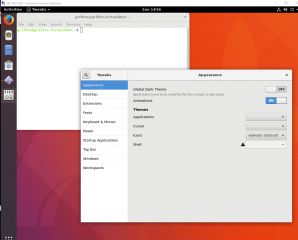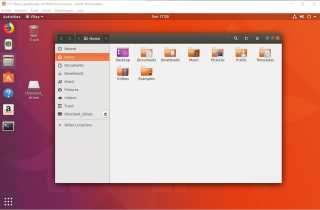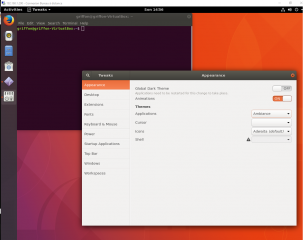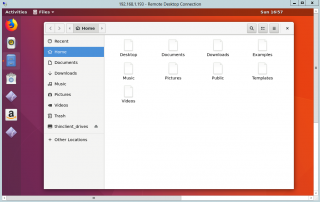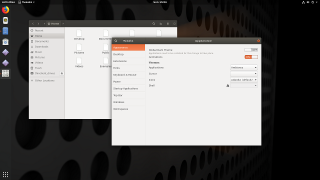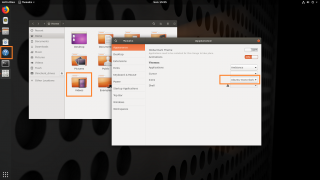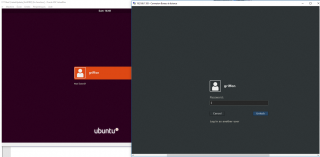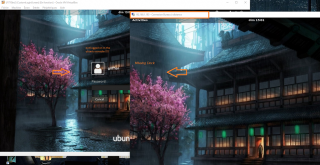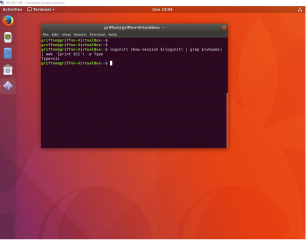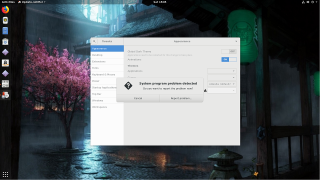Hello World,
The last three posts have been focusing on installing xRDP on Ubuntu 17.10 and Gnome Desktop. In part I, a step by step instruction guide has been provided in order to perform a manual installation of xRDP on top of Ubuntu 17.10. In Part II, a quick and dirty script has been developed in order to automate the installation of xRDP as much as possible. This would speed up the installation process of xRDP standard package on Ubuntu 17.10. In part III, the “famous”custom installation script has been updated so a custom installation can be easily performed on Ubuntu 17.10. The script has been updated the reflect the recent changes in the Canonical strategy in the Desktop Operating System field….
These posts will help you in installing an configuring xRDP on Ubuntu 17.10 while using the new Gnome Desktop interface customized by Canonical. However, the more you use the xRDP solution, the more you discover small issues that can be annoying or blocking factors. After the initial installation, you might not be 100 % happy with the look n feel of your Ubuntu Gnome Desktop when accessing it through xRDP software….
This post will describe some of the small issues that have been found when connecting through xRDP and how to fix it…. So, let’s see what we are talking about…..
xRDP & Ubuntu Gnome 17.10
Assumptions
For this post, we have make some assumptions.
- The Ubuntu 17.10 final release will be used
- At time of writing, all available updates were installed on the Ubuntu machine
- No alternative Desktop will be used. Default Gnome desktop will be the default desktop accessible via the xrdp session
- We are using the standard xrdp package available within the Ubuntu repository for Ubuntu 17.10
- Ubuntu machine has been installed as virtual machine using Virtualbox software
- Default session used is Wayland (it’s supported in Virtualbox)
- xRDP from Official Ubuntu repository has been installed and it’s working….
Small look’n feel issues
In this section, we will cover the look n feel issues we have encountered. These issues are really minor and will not prevent you to work. On the other hand, we believe that the visual aspect of the desktop is really important to the user and we need to ensure that most of the functionalities available at console are available in the remote session..
Remote session Ubuntu Theme is different or not set
A minor issue people might want to fix is the default Ubuntu theme to be used. Within the remote desktop session, the Ubuntu theme is not applied by default or it’s kind of mangled as seen in the screenshot below
Click on picture for better resolution
When connected locally on the machine, the ambiance theme is present and give a recognizable working environment and desktop look ‘n feel to Ubuntu.
Click on picture for better resolution
Based on these two screenshots, we can clearly see a difference in the Theme used when logged on locally on the machine and when connected remotely on the system. The terminal console background is white and there is no dark bar on top of the windows… The fix is actually quite simple…
To fix this visual issue, you simply need to open Gnome Tweak > Appearance, under the Themes section, the applications field is empty. Changing this value to Ambiance will set the standard look to your remote session.
Click on picture for better resolution
As soon as you have selected the option, you should see that the well known Ambiance Theme is applied to your Remote session…
Remote session missing Icons
Another small visual issue you might encountered is related to the icons available through the remote session. On the screenshot below, you can see that the folder icons are missing and we have only a white icon visual (which is really ugly). Note also the icons on the Dock section. Again, you can see that we are missing some of them and they have been replaced by a standard purple icon
Click on picture for better resolution
Again the fix for this visual inconvenience is to use Gnome Tweak Tool. If you open Gnome Tweak > Appearance, under the Themes section, the icons field is set to Adwaita
Click on picture for better resolution
Changing this value to Humanity or Ubuntu-xxx option will set the standard look to your remote session.
Click on picture for better resolution
GDM Login page color inconsistent
The GDM login page background page displayed on the local computer and on the remote session will be different. On the local computer, you can see the customized purple gdm login screen. However, when logged into the remote session and for whatever reason you need to login again, you can see that the Login background screen color is not the purple one but the default gray one used by gnome.
Click on picture for better resolution
For this one, we have not find a fix yet…
Things to keep in mind when using xRDP on Ubuntu 17.10
A single user can access console and remote session
This is the most annoying one. In the past, the same user could be locally logged on on the system and still perform a remote connection to the same machine. Nowadays, this does not seems to be the case anymore. If the user is connected through remote desktop session, and if the same user tries to connect to the console, the login process will loop. If the user is logged into the console, the remote session will only show a black screen. So this point is still not fixed…..
Click on picture for better resolution
Reconnect to an existing Remote Session
As long as you are not locally logged on into the Ubuntu machine, you will be able to reconnect to existing remote session. This means that you can start working from one location on one specific computer, make a remote session, perform some works and then disconnect your session. You can then move to another workstation, start your remote desktop client and you will be reconnecting the same session. We have performed this test and it’s working.
Session type
Ubuntu 17.10 is using Wayland as Default Display Server, it was a surprise that xRDP is indeed still working. After some basic checks, xRDP can still work because the implementation is falling back to the X11 session type (as seen on the screenshot)
Click on picture for better resolution
The big question is to see if Wayland will integrate remote desktop capabilities and see if xRDP will develop a new version that would support Wayland only. Somewhere in the future, Xorg session might go away and we simply hope that new initiative will be taken to provide similar remote session capabilities..
Note :
If you are using Hyper-v as virtualization platform, the UBuntu 17.10 Virtual machine will fallback to X11 session type as default session. Hyper-v does not seems to support the new Wayland Display Server.
System Crash in Remote Sessions
Time to time (at login especially), a system crash popups appear on the system. So far, we have not been able to detect or fix this issue..It’s really a minor annoyance and does not really prevent you to work on your system. This issue might show up or might not.. This one is really random.
Click on picture for better resolution
Final Notes
Voila ! We are done. In the recent previous posts, we have covered the xRDP installation and configuration on Top of Ubuntu 17.10. Since Ubuntu 17.10 (and later versions) will be using Gnome Desktop as main desktop, an update about this topic was needed. All in the all, the process has not changed much. We can still use xRDP against Ubuntu 17.10 running the Gnome Desktop. When remoting into the system, we can improve the look’n feel of the session to try to match as close as possible the console session.
We are looking forward to see what Ubuntu 18.04 will be bringing next year
till next time
See ya
